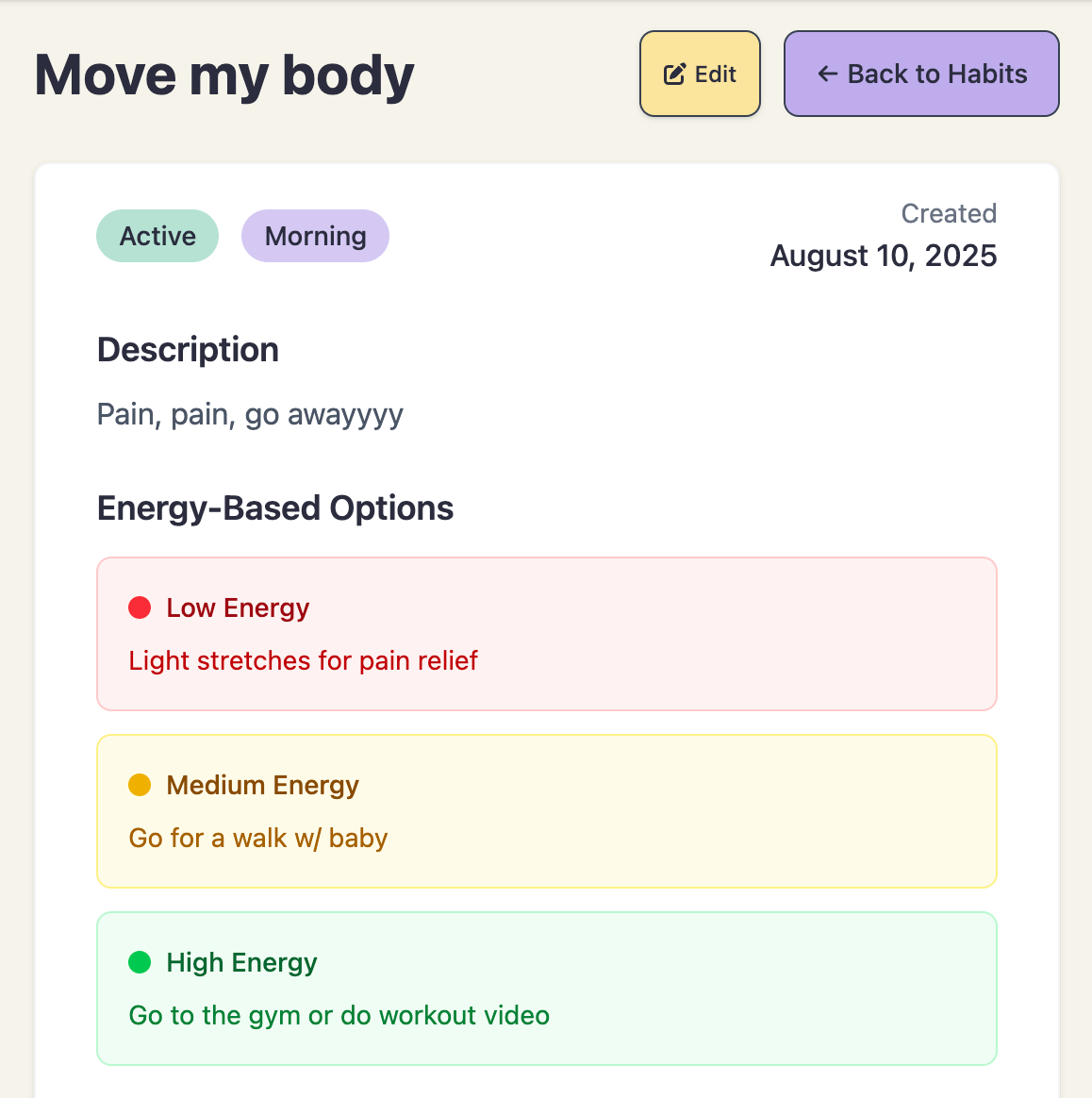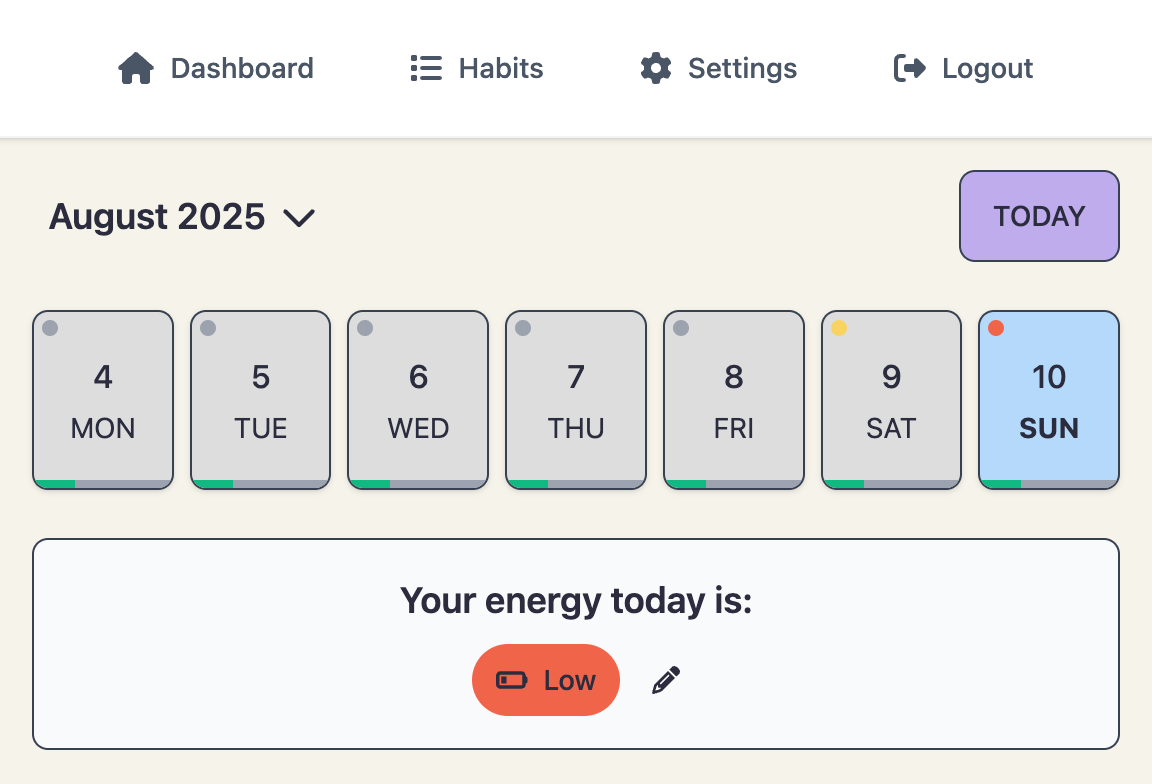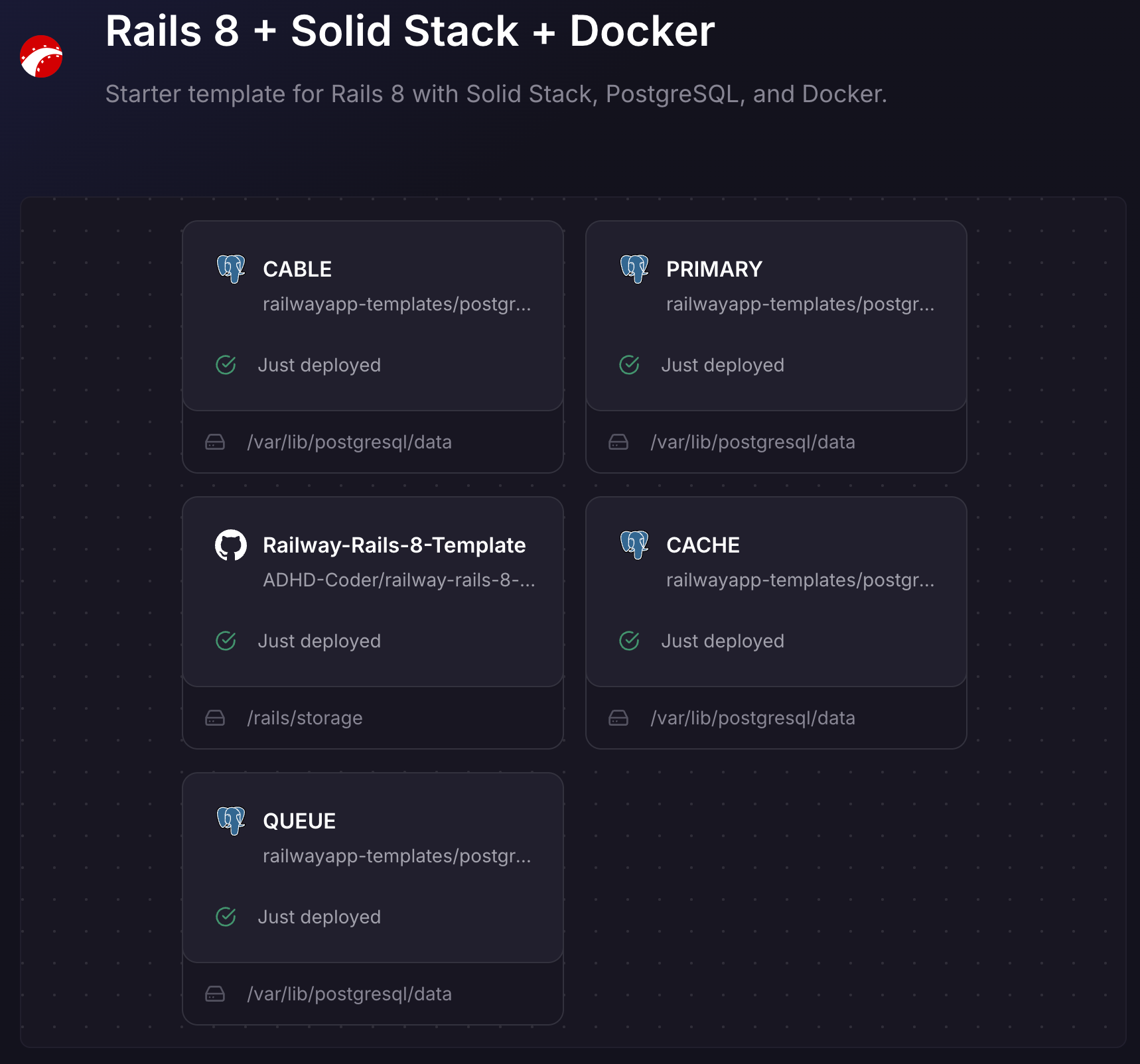Remember the last blog post about finishing projects?
Well... I actually finished a project!!! 🎉
I built Do & Don't, the habit tracker I wish I had during my worst ADHD & Postpartum Depression days, for Railway's recent hackathon. And honestly? It feels pretty incredible.
The Problem I'm Trying to Solve
Most habit trackers are designed for people with consistent energy... And I am not one of those people.
All the apps out there expect linear progress and daily consistency.
For ADHD, depression, executive dysfunction, etc... some days you're on fire. Other days, getting up is the win.
I've tried soooooo many productivity tools (seriously, don't scroll my iphone app purchases 😅). None of them work with my capacity.
Polar Habits was the closest I found. It's a fantastic, guilt-free habit tracker that focuses on momentum instead of streaks, so missing a day doesn't reset you to zero. But I still couldn't stick to doing the same habit every day, even without the pressure.
What I really wanted was something that lets me pay attention to my body and mental health, instead of fighting against them.
I learned a lot about this from the spoon theory: Some days I have more spoons, some days I don't, and shame compounds when I can't do "basic" things like self-care.
So I Built Something Different
I built a habit tracker that meets me where I'm at, not where I "should" be.
Here's how it works...
First, you'll create habits based on OUTCOMES. Why do you want to do this habit in the first place? Instead of "brush teeth every day" the outcome is "clean, good looking teeth" or instead of "exercise 4x per week" the outcome you might want is "feel good in my body" or "move my body in a way that feels good"
See the difference? This was the first change I made from the typical apps. I wanted to see WHY I was doing something, not what I had to do.
Then I created the actual "habits" for each energy level...
- 1 = low energy... what's the bare minimum I can do on a low energy day that would be a quick, guaranteed win and that would help me reach the outcome of this habit?
- 2 = medium energy... what's something I'd like to do consistently if I have the energy for it?
- 3 = high energy... how do I go all out, balls to the wall, full enthusiasm, I'm on fire, I'm gonna do it all? 🤪 (I may be in a state of mania for these days, but who knows)

Here's some other real examples from my life:
Habit Outcome: "Get ready for the day"
- Energy 1: Stay in pajamas
- Energy 2: Put on clothes I could go out in
- Energy 3: Pick a cute outfit and do makeup
Habit Outcome: "Clean hair"
- Energy 1: Dry shampoo
- Energy 2: Wash hair and air dry
- Energy 3: Wash & dry & style
Every option is a win because you're acknowledging where you're at and doing what you can to achieve the outcome you're desiring from the habit. Everything has a purpose, and everything helps you win.
Also, I was semi-joking about level 3 (high) energy above, but seriously some of these examples like washing, drying, AND styling my hair feels like a HUGE win and a HUGE amount of energy expenditure for me. Everyone's going to be different with this, which is why I love how flexible this can be.
The D&D Connection (And Why I Named It This)
I called it Do & Don't as a nod to Dungeons & Dragons. Because honestly, my daily energy and mental health feel like rolling a d20... sometimes I roll so low over and over again and my days just totally suck... sometimes I roll a nat20 and I'm unstoppable. I wanted this app to acknowledge that reality instead of fighting against it.
In the future, I want to make it more gamified... quests, leveling up, building a skill tree for real life, seeing your progress in character progression and more "roleplay" and "game" like features (maybe actual rolling dice?).
But for this hackathon, I kept it simple.
The win here wasn't just building it. It was finishing the MVP and making it something I could actually use.
This hackathon gave me the accountability I needed to stop tinkering and actually ship something 🙏

Railway Hackathon
I always have big ideas and struggle to break it down into small chunks. This hackathon definitely forced me to focus on building a true MVP with only the most necessary features.
Configuring my app for deployment was... something. Started trying to cram Solid Stack into one database, didn't understand Docker, rage-deleted the Dockerfile (it worked with Puma but still...).
The challenge: I wanted to do Rails 8 + Solid Stack + Docker + multiple databases properly.
Lifesaver resource: This GoRails "How to Configure Multiple Databases with Rails" video helped me figure out how to set up the databases for solid cache, cable, and queue.
Deployment used to scare me more than a 7AM meeting 😂 But Railway seriously made it super easy to do. PLUS, their Railway Station is incredible! I asked a question to get help on my configuration, and they set a bounty for it and a ton of people helped! That was super cool 😄 and I loved awarding someone with the bounty too.
AND I made a template from my Rails 8 set up!
Railway's current tutorial is for Rails 7, so this gets you started with Rails 8 + Solid Stack + Docker.
As of writing this blog post, 2 people have already deployed and used it for live projects... I was happy just being able to speed up my own workflow. But the fact that it's already helping others after just recently publishing this template is amazing 😭 Railway is doing a great job at being community-led.

It's not perfect, but hopefully helpful for getting started and actually publishing projects. The template has a quick deployment guide on GitHub too.
What I Learned Building This
- Energy awareness changes everything. Acknowledging your capacity instead of fighting it makes a huuuuge difference.
- The hackathon deadline was exactly the accountability I needed to actually get one of my ideas shipped finally 😅
- MVP mindset is crucial. Had to resist the urge to add all the gamification features right away (future me will thank present me for this restraint).
- Railway makes deployment actually accessible for junior devs. I went from deployment anxiety to confidently shipping MULTIPLE projects (more blog posts about that soon 😉). Plus, the auto-scaling means I don't have to guess at resources, and the GitHub integration means every push automatically deploys after passing all tests.
- Creating templates and resources makes the ecosystem better for everyone 💜 EVEN IF imposter syndrome is rampant.
Try It Yourself
If you're neurodivergent, burnt out, or just tired of habit apps that assume you're at 100% every day, try out my app. I'd love to hear your feedback on it too!
If you're building in Rails 8, use my Railway template: Rails 8 Railway Template. It's literally one click to deploy a full Rails 8 app with Solid Stack and multiple database support.
For fellow junior devs struggling with deployment: Railway changed my whole relationship with shipping projects. No more deployment anxiety, no more guessing at server configurations. Just focus on building.
And note to self and any other devs feeling insecure about your ideas... Your imperfect projects still have value. Build them anyway. 💜
For neurodivergent peeps: Your energy levels aren't bugs to fix, they're features to design around 🙏
If you're just here for the chaos: hi, welcome, I love you.
What's Next
Actually using my own app consistently (the ultimate test).
Oh, and more gamification features: The D&D theme has so much potential for making habit tracking actually fun.
But first: Celebrating that I shipped something instead of endlessly tinkering 🥳
What habits would you break down by energy level? Let me know! I'm genuinely curious what this looks like for other people.
I might be adding habit templates in the future 👀
P.S. If you want to follow along with more experiments like this, I write about the messy reality of coding, creating, and living with ADHD. No perfect productivity advice here, just real stories and tools that actually work for brains like ours. Subscribe below to stay updated 💜
Subscribe to our email newsletter and unlock access to members-only content and exclusive updates.

Comments